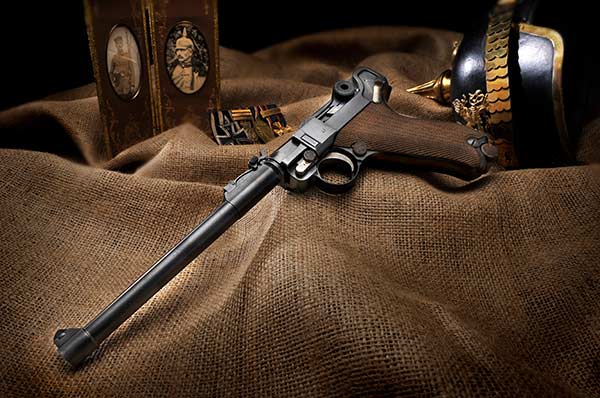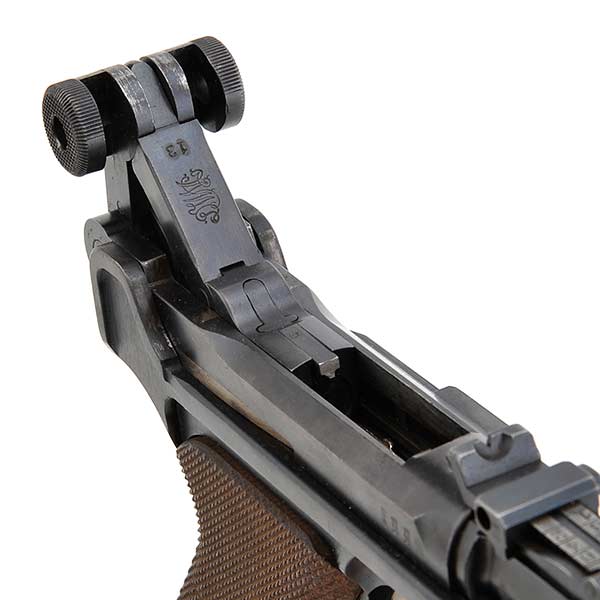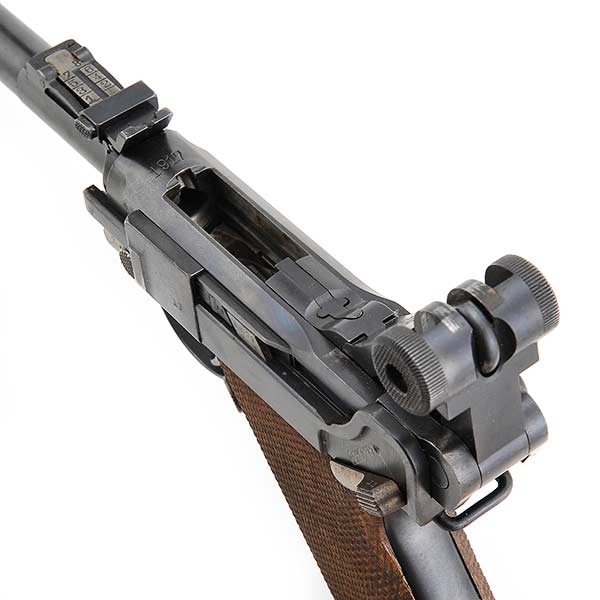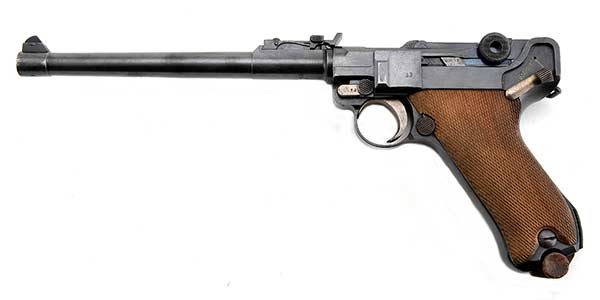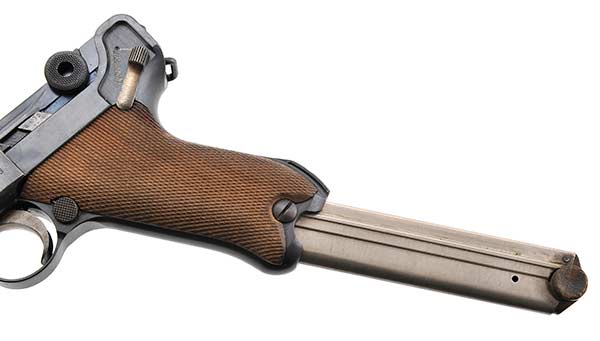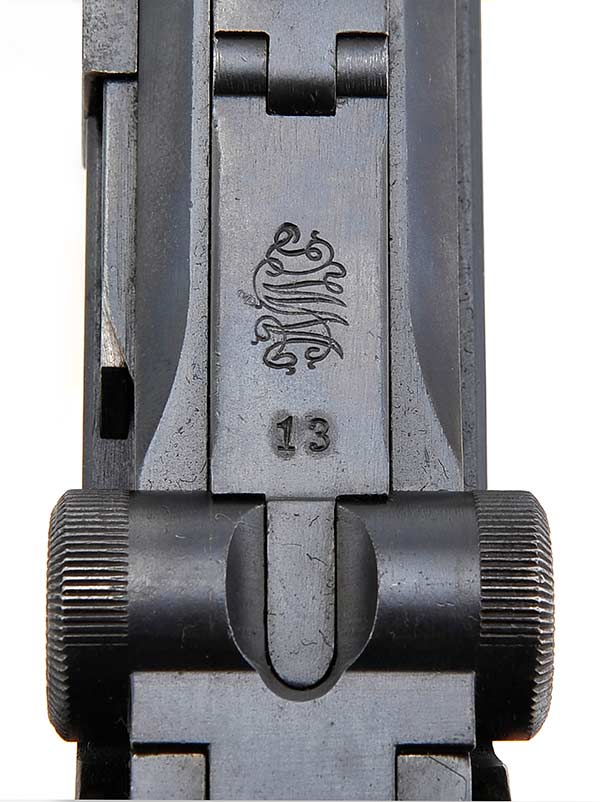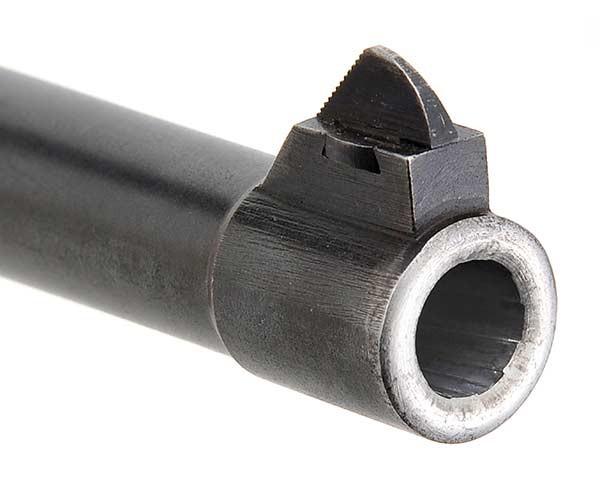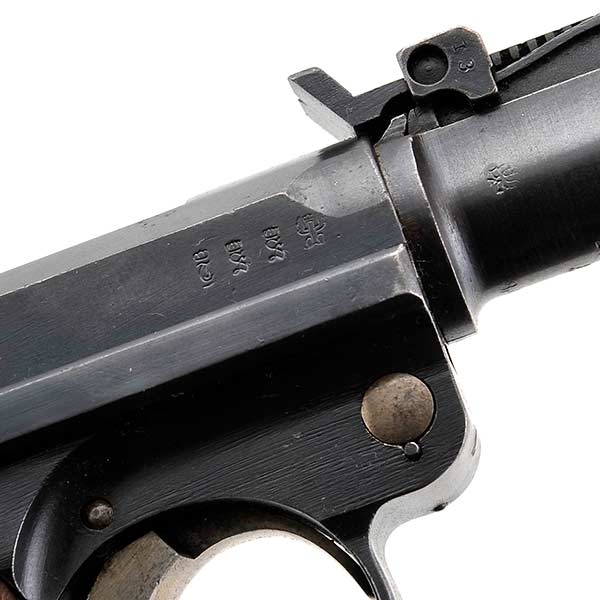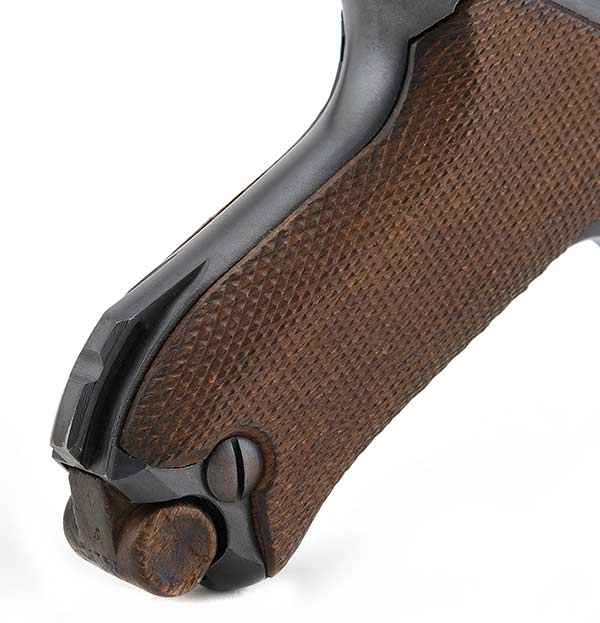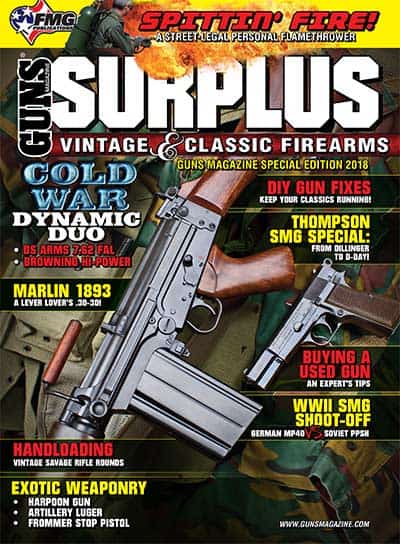The Kaiser's Secret Weapon
The WWI-era German 9mm “Artillery Luger”
delivered firepower ahead of its time.
The world in 1917 was a hemorrhaging wound. Like toddlers wielding hand grenades, world leaders commanded armies numbered in the millions in a pitiless war of attrition that claimed human life on a magnitude previously unimagined. Countless lives were ruined, and immeasurable blood was spilt. Thus we as a species received our gory introduction to warfare on a truly industrial scale.
Desperation inevitably spawns innovation. Nations suddenly shocked by their battlefield losses struggled to improve weapons and equipment in an effort at offering their combatants some tactical advantage on killing fields like Ypres, Verdun and the Somme. The resulting mad dash for the latest military technology brought us armed aircraft, poison gas and the combat submarine. On scales both small and large the world saw unprecedented innovation in military hardware.
In the latter years of the 19th century, the state of the art in military handguns was some variation on Rollin White’s bored-through cylinder. Mr. White worked as a contract gunsmith at Colt in the years preceding the American Civil War, and his revelation that a revolver cylinder could be loaded with cartridges from the rear revolutionized handguns. He subsequently sold his invention to Smith & Wesson in exchange for a 25-cent royalty on each pistol produced. By the late 1800’s, however, it was time for something new.
In 1893 Hugo Borchardt designed the Borchardt-Selbstladepistole while working for the German firm of Ludwig Loewe & Cie of Berlin. Compared to the competition, Herr Borchardt’s magazine-fed repeater was a quantum leap forward. The resulting handgun was bulky and expensive and, remarkable though it was, failed to generate any significant military sales.
Georg Luger, one of Hugo’s fellow engineers, was granted a patent for an improved version of the Borchardt-Selbstladepistole in 1898. Evolutionary improvements resulted in the 1900 pattern pistol sold in quantity to the Swiss military through the newly formed Deutsche Waffen- und Munitionsfabriken (DWM). In 1903 the Imperial German Navy accepted the design and in 1908 the Kaiser’s army followed suit. Hence was birthed the Parabellum P08, arguably the most iconic handgun in human history. Today it is simply called the Luger.
Human Anatomy Meets Martial Efficiency
The action of Herr Luger’s eponymous pistol reflects an inspired adaptation of the human knee joint. When fully extended the human knee will support a person’s body weight without any significant muscular involvement. This extraordinary design allows us to remain standing throughout tedious political oratory, graduation ceremonies and moving wedding nuptials without having to expend undue metabolic capital. However, once the knee’s angle advances past a certain tipping point the joint breaks, and the associated musculature assumes responsibility for the limb’s structural integrity. Luger and Borchardt envisioned within this phenomenon a gun’s mechanical action.
If you’ve never before appreciated the genius of Luger’s Parabellum, grab up a copy or Google a close-up photograph and follow the action through its cycle. It embodies mechanical elegance. The cam governing the action is machined into the frame of the gun such that the mechanism is fully on display to the outside observer.
The toggle component locks the action closed when fully extended. Newtonian physics dictates the recoil force counteracting the expulsion of the projectile presses the upper half of the gun backwards against counter-pressure exerted through the firer’s arm. The P08’s upper half is designed to slide freely in a linear track along the frame, allowing the central hinge of the toggle to impinge upon the cam defined by the frame and push the joint upwards until it unlocks. Momentum then drives the action up and open against spring pressure so the extractor and ejector can rid the gun of its spent cartridge. The coil-shaped recoil spring in the grip then reverses the process, stripping a round from the gun’s magazine and returning the action to its locked state. The simplicity, sophistication and mechanical grace of the process are — quite literally — inspired.
The trigger is not as crisp as it could be given its single-action design. The externalized nature of the mechanism also leaves the gun susceptible to fouling in the face of grime and filth, something found in abundance in the trenches of the Great War. However, the gun is accurate for its dimensions and in its pedestrian form gives its operator eight rapid fire rounds on tap. With the standard 3.74″ barreled version as a starting point, German engineers redesigned the pistol into something that could better serve as a serious close combat tool.
Find A Need And Fill It
The intimacy implicit within a grunt’s personal weapon has fascinated historians and military buffs for time immemorial. However, it is actually the Field Artillery that is the apex predator on the modern battlefield. The art of the cannonade has evolved from crude massed saturation fire to the precision application of high explosive encased in steel. As a result, an Army’s artillery assets are critical elements worthy of protection.
The World War I-era artilleryman managed a remarkably complicated piece of precision machinery in unbelievably austere conditions. The guns and their associated support structure required a great deal of technical expertise for effective use. Redlegs, as they are called in US Army parlance, must manipulate and manhandle heavy equipment and projectiles while calibrating guns and sighting gear to ensure they drop their rounds on time and on target. Friendly lives hang in the balance. In this environment, cumbersome full-sized personal weapons are not ideal.
In a perfect world an artilleryman’s individual weapon is simply ballast. It is the cannon with which he engages the enemy. If combat exigencies demand this soldier engage in close fight, then something has gone desperately wrong. However, on a fluid modern battlefield an enemy offensive might conceivably penetrate into an army’s rear areas with sufficient speed to threaten artillery units. Under these circumstances, artillerymen needed a compact weapon that remained capable of providing close-range firepower. German engineers in the early 20th century appreciated their artillerymen needed what we have now come to call a “Personal Defense Weapon.”
The Lange Pistole 08
The requirement for a pistol carbine with which to arm German artillerymen was actually recognized in 1907, and several different handgun chassis were evaluated towards this end. In 1908, Captain Adolf Fischer was tasked to work with DWM to finalize the design. The resulting Lange Pistole 08 (literally “Long Pistol 08”) was a pistol carbine version of the basic Parabellum action that is now universally referred to as the Artillery Luger. Kaiser Wilhelm II personally approved the design on June 3, 1913.
This adaptation of the toggle-joint P08 sports a 200mm barrel, an eight-position tangent rear sight rather optimistically calibrated out to 800 meters, a detachable shoulder stock cut from simple board stock and a complicated 32-round snail drum magazine designated the Trommelmagazin 08. Considering a 115-grain 9mm round drops around 35 feet at 500 meters the long-range sight is fairly superfluous. The entire affair was issued with a dedicated leather holster to manage all the ancillary bits. The earliest Artillery Lugers sported micrometer adjustable front and rear sights that required a dedicated two-pin tool for adjustment. This superfluous feature was deleted in the 1917 production.
The Artillery Luger’s support equipment was issued in a dedicated wooden storage box called a P-Kasten. This case carried five drum magazines along with the magazine loader and 12 boxes of ammunition. Complete versions of this kit are rarer than unicorn horns today.
Practical Tactical
Though the Artillery Luger was originally intended as an artilleryman’s close quarters combat tool, its other applications were readily appreciated. Once the First World War battlefield stalemated into a classic trench fight, engagements frequently distilled down to small unit commando-style affairs. These actions involved small groups of highly trained shock troops that would infiltrate enemy trenches to snatch prisoners, gather intelligence, or foment local breakthroughs. In such a battlespace the appeal of a lightweight, maneuverable pistol-caliber carbine with a large magazine capacity became apparent. Dedicated units formed for this task within the Kaiser’s army were called Sturmtruppen or Stormtroopers.
The Sturmtruppen carried medieval-style steel shields and entrenching tools with cutting surfaces ground to a razor’s edge. They frequently adorned their helmets with a stylized death’s head to better intimidate their opponents. Their weapons included both the Artillery Luger as well as the revolutionary MP-18 submachine gun, the world’s first successful dedicated pistol-caliber automatic weapon. Such stuff went on to define the small unit tactics of the subsequent War to End All Wars some two decades later.
The Lange Pistole 08 was also evaluated as a weapon with which to arm combat aviators. The earliest tactical heavier-than-air aircraft used in World War I were flown little more than a decade after the Wright brothers’ first flight, and aviation technology was far from rarefied. In this case these earliest military aviators would take potshots at one another using variations of the same small arms used by their ground-bound brethren. The Artillery Luger was tested specifically to assess its utility within the confines of an aircraft’s cockpit as well as the effectiveness of the 9mm round against the aircraft engines of the day. Such technical research was obviously rendered superfluous after the first belt-fed machine guns designed to fire synchronously through an airplane’s propeller arc became widely available.
Tools Of Tragedy
The Artillery Luger variation of the P08 Parabellum pistol was a timely adaptation driven by the exigencies of total war grown out of control. The machines that produced these firearms were conceivably still driven by steam. Wielding nothing more advanced than a ruler such luminaries as Hugo Borchardt, Georg Luger and Adolf Fischer conjured weapons with an elegance seldom equaled today even in the era of computer-aided design and CNC milling machines.
History has a tendency to overlook the misery of the battlefield. The timeless pathos that is modern war is frequently ignored in favor of technical treatises on a soldier’s tools or the general’s strategic cerebrations. That young soldiers fighting and dying far from home clutched these guns makes the ownership of such treasures as much responsibility as privilege. While mankind seems incapable of learning any grand moral lessons from the horrors of modern war, we nonetheless appreciate the elegance of the tools. In the elements of Adolf Fisher’s adaptation of Georg Luger’s magnificent mechanical knee, we can glimpse a bit of military necessity bordering upon art.
Special thanks to www.worldwarsupply.com
for providing the photography to support this article.
Lange Pistole 08 Artillery Luger
CALIBER: 9mm Parabellum
BARREL LENGTH: 7.87″
OVERALL LENGTH: 12.87″
WEIGHT: 2 lbs.
STOCK/GRIPS: Wood
SIGHTS: Tangent rear, blade front
ACTION: Toggle-lock short recoil
FINISH: Blue
CAPACITY: 8-round box magazine or 32-round drum

